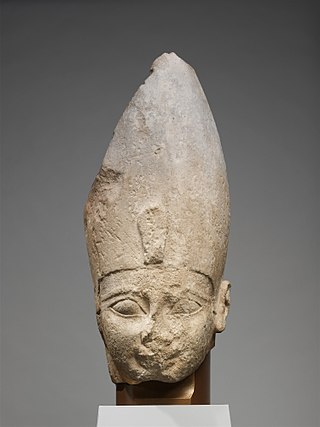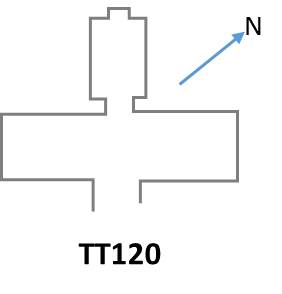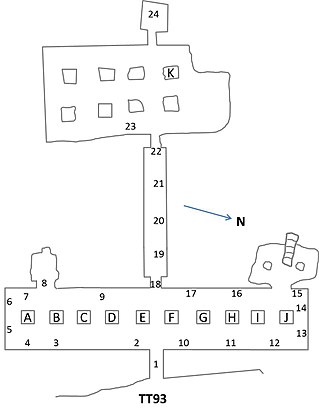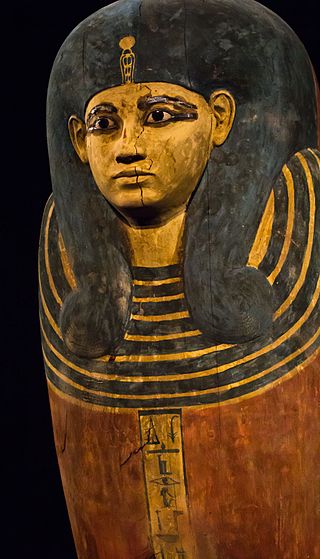
Ahmose I was a pharaoh and founder of the Eighteenth Dynasty of Egypt, classified as the first dynasty of the New Kingdom of Egypt, the era in which ancient Egypt achieved the peak of its power. He was a member of the Theban royal house, the son of pharaoh Seqenenre Tao and nephew of the last pharaoh of the Seventeenth dynasty, Kamose. During the reign of his father or grandfather, Thebes rebelled against the Hyksos, the rulers of Lower Egypt. When he was seven years old, his father was killed, and he was about ten when his brother died of unknown causes after reigning only three years. Ahmose I assumed the throne after the death of his brother, and upon coronation became known as Nebpehtyre, nb-pḥtj-rꜥ "The Lord of Strength is Ra".

Amenhotep I, Amenôthes I, or Amenophis I, (,) from Ancient Greek Ἀμένωφις, additionally King Djeserkare, was the second Pharaoh of the 18th Dynasty of Egypt. His reign is generally dated from 1526 to 1506 BC. He was a son of Ahmose I and Ahmose-Nefertari, but had at least two elder brothers, Ahmose-ankh and Ahmose Sapair, and was not expected to inherit the throne. However, sometime in the eight years between Ahmose I's 17th regnal year and his death, his heir apparent died and Amenhotep became crown prince. He then acceded to the throne and ruled for about 21 years. Although his reign is poorly documented, it is possible to piece together a basic history from available evidence. He inherited the kingdom formed by his father's military conquests and maintained dominance over Nubia and the Nile Delta but probably did not attempt to maintain Egyptian power in the Levant. He continued the rebuilding of temples in Upper Egypt and revolutionized mortuary complex design by separating his tomb from his mortuary temple, setting a trend in royal funerary monuments which would persist throughout the New Kingdom. After his death, he was deified as a patron god of Deir el-Medina.
Boyo Ockinga is an Egyptologist, epigrapher, and philologist of the ancient Egyptian language, who holds the position of Associate Professor in the Department of Ancient History at Macquarie University in Sydney, Australia.

The necropolis of Draʻ Abu el-Naga' is located on the West Bank of the Nile at Thebes, Egypt, just by the entrance of the dry bay that leads up to Deir el-Bahari and north of the necropolis of el-Assasif. The necropolis is located near the Valley of the Kings.

Tomb TT188, located in the necropolis of El-Khokha in Thebes in Egypt, is the tomb of the Steward and King's Cupbearer Parennefer. It has been excavated by the Akhenaten Temple Project. The work has been thoroughly published by Susan Redford with architectural study and drawings by Keith Meikle.

The Valley of the Kings, also known as the Valley of the Gates of the Kings, is a valley in Egypt where, for a period of nearly 500 years from the 16th to 11th century BC, rock-cut tombs were excavated for the pharaohs and powerful nobles of the New Kingdom.

Tomb TT192, located in the necropolis of El-Assasif in Thebes, Egypt, is the tomb of Kheruef, also called Senaa, who was Steward to the Great Royal Wife Tiye, during the reign of Amenhotep III. It is located in El-Assasif, part of the Theban Necropolis.
The ancient Egyptian official named Menna carried a number of titles associated with the agricultural estates of the temple of Karnak and the king. Information about Menna comes primarily from his richly decorated tomb in the necropolis of Sheikh Abd al-Qurna at Thebes. Though his tomb has traditionally been dated to the reign of Thutmose IV, stylistic analysis of the decoration places the majority of construction and decoration of the tomb to the reign of Amenhotep III.

The Theban Tomb TT120 is located in Sheikh Abd el-Qurna. It forms part of the Theban Necropolis, situated on the west bank of the Nile opposite Luxor. The tomb is the burial place of the ancient Egyptian official Anen, who was the brother of Queen Tiye, and became Chancellor of Lower Egypt, Second Prophet of Amun, sem-priest of Heliopolis, and Divine Father under the reign of Amenhotep III.
Lyla Pinch Brock is a Canadian Egyptologist, specializing in epigraphy. She lives in Saissac, France.

The Theban Tomb TT57 is located in Sheikh Abd el-Qurna. It forms part of the Theban Necropolis, situated on the west bank of the Nile opposite Luxor. The tomb is the burial place of the ancient Egyptian official Khaemhat, who was royal scribe and overseer of double granary, during the reign Amenhotep III. The relief decoration of the tomb is regarded as the best of New Kingdom art.
The majority of the 65 numbered tombs in the Valley of the Kings can be considered minor tombs, either because at present they have yielded little information or because the results of their investigation was only poorly recorded by their explorers, while some have received very little attention or were only cursorily noted. Most of these tombs are small, often only consisting of a single burial chamber accessed by means of a shaft or a staircase with a corridor or a series of corridors leading to the chamber, but some are larger, multiple chambered tombs. These minor tombs served various purposes, some were intended for burials of lesser royalty or for private burials, some contained animal burials and others apparently never received a primary burial. In many cases these tombs also served secondary functions and later intrusive material has been found related to these secondary activities. While some of these tombs have been open since antiquity, the majority were discovered in the 19th and early 20th centuries during the height of exploration in the valley.
Amenemipet called Pairy was a Vizier of ancient Egypt. He served during the reign of Amenhotep II and Tuthmosis IV.
The Theban Tomb TT23 is located in Sheikh Abd el-Qurna, part of the Theban Necropolis, on the west bank of the Nile, opposite to Luxor. It is the burial place of the ancient Egyptian official, Tjay or Thay called To, who was a royal scribe of the dispatches of the Lord of the Two Lands, during the 19th Dynasty. Thay served during the reign of Merenptah.

The Theban Tomb TT93 is located in Sheikh Abd el-Qurna, part of the Theban Necropolis, on the west bank of the Nile, opposite to Luxor. The tomb belongs to an 18th Dynasty ancient Egyptian named Qenamun, who was the overseer of the cattle of Amun and chief steward of Amenhotep II. More than eighty epiteths of Qenamun were found in the tomb. Qenamun's mother, Amenemipet, was a wet nurse of Amenhotep II, which effectively made Qenamun a foster brother to the young prince that would become king.

The Theban Tomb TT358 is located in Deir el-Bahari, part of the Theban Necropolis, on the west bank of the Nile, opposite to Luxor. The tomb belongs to the king's wife Ahmose-Meritamun, the sister and the wife of Pharaoh Amenhotep I. The tomb was later used for the additional burial of the King's daughter Nany, who was a daughter of Pharaoh Pinedjem I.
North Asasif – is a part of the Theban Necropolis located on the bottom and sides of the valley, along the processional ways leading to the royal temples in Deir el-Bahari: temples of Mentuhotep II, Hatshepsut, and Thutmose III. It encompasses private tombs dating from the Middle Kingdom to the Ptolemaic period. Evidence has been found of strong ties between Asasif and Deir el-Bahari through the ages.
Theban Tomb TT72 is located in the Theban Necropolis, on the west bank of the Nile, opposite to Luxor. It was the tomb of Re, who was the First Prophet of Amun in the Mortuary temple of Thutmosis III. The tomb is located in the necropolis area around Sheikh Abd el-Qurna and dates to the time of Amenhotep II.

The Theban Tomb TT120 is located in Sheikh Abd el-Qurna. It forms part of the Theban Necropolis, situated on the west bank of the Nile opposite Luxor. The tomb is the burial place of the ancient Egyptian official Ahmose, who was the second prophet of Amun-Ra at Karnak and later the first prophet of Amun at Henqet-Ankh, the mortuary temple of Tuthmosis III at Qurnah during the reign of the Tuthmosis III.











